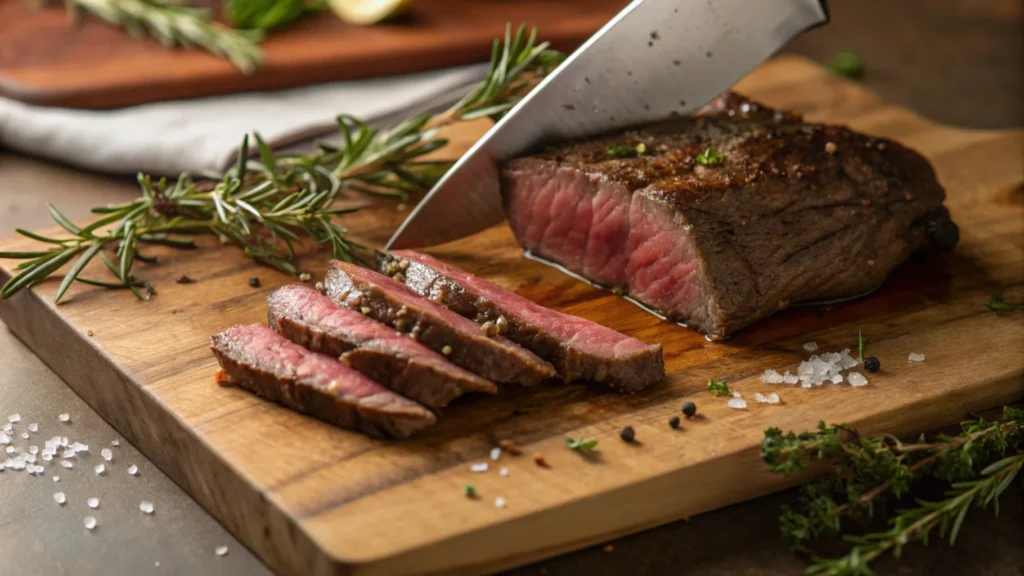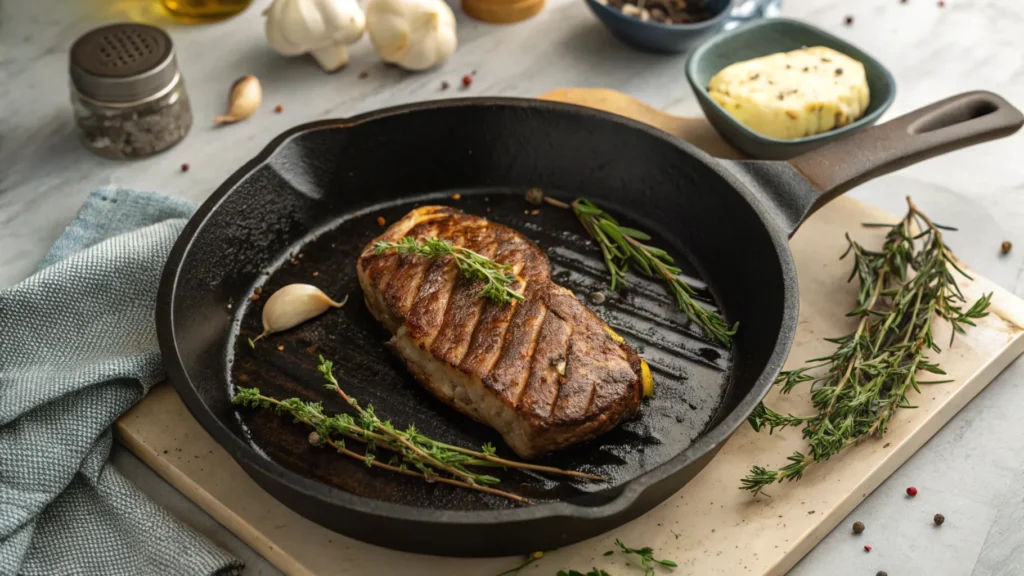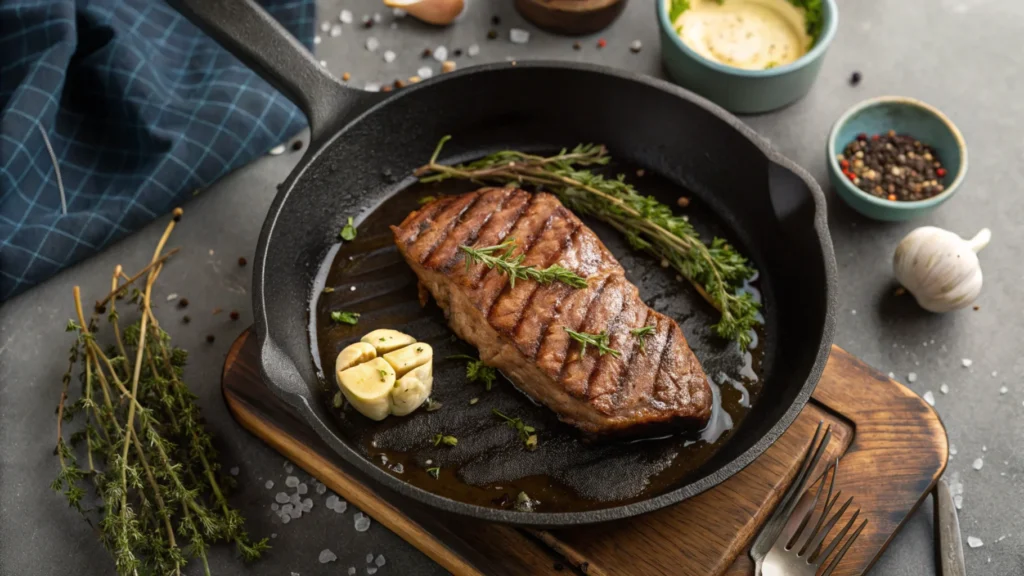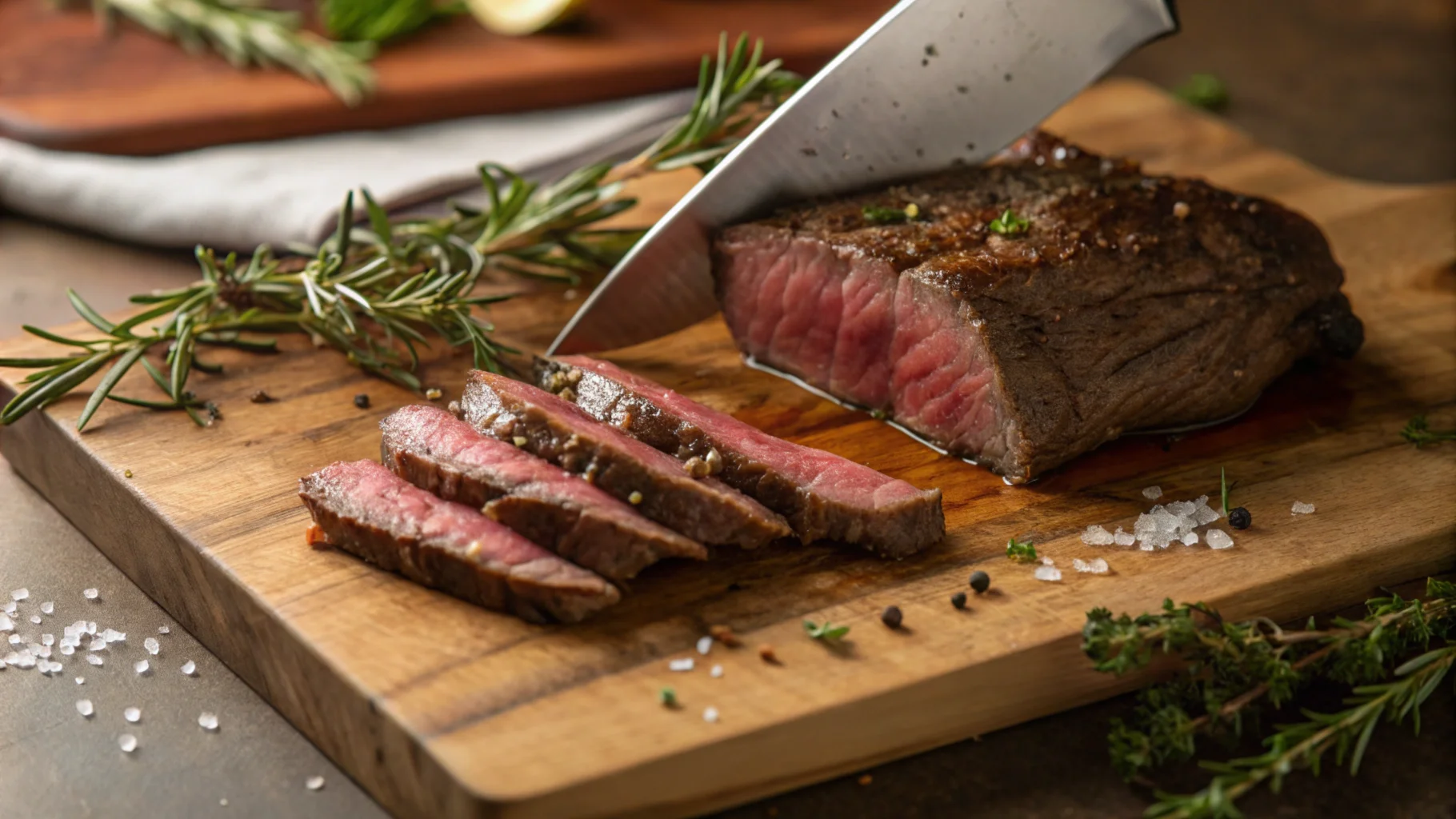Flat iron steak, a premium cut of beef, is highly regarded for its tenderness, rich flavor, and excellent marbling. Sourced from the chuck primal, flat iron steak offers a steakhouse-quality experience similar to high-end cuts like ribeye, but at a more affordable price. Its slightly higher cost comes from the careful cutting process and rising demand. When cooked well, this steak provides great value and flavor.
For additional meal ideas, consider what meals can be made from chicken thighs. This versatile and flavorful ingredient is perfect for creating a variety of satisfying dishes.

Table of Contents
Unique Characteristics of a Premium Steak Cut: Flat Iron Steak
This cut is distinct in terms of its texture and flavor profile. Unlike tougher cuts from the same region, it has a high degree of marbling, contributing to a rich and buttery flavor. The cow doesn’t use the muscle from which this steak is derived as much, making it naturally tender. Additionally, it has a uniform shape, which makes it appealing to chefs and consumers alike.
- Marbling: The amount of fat interspersed within the muscle contributes to its moistness and rich taste.
- Tenderness: People often compare this cut to more expensive options like ribeye or filet mignon because it offers comparable softness.
- Flavor Profile: The flat iron steak has a savory flavor, making it a versatile choice for grilling, pan-searing, or broiling.
The combination of these characteristics makes the flat iron steak a standout, yet also a cut that demands more attention in terms of pricing.
The Cutting Process of a Premium Steak Cut
Getting this premium cut requires skill and care. The chuck primal is tougher, but it can be made tender if handled right. Butchers first remove a silverskin, a tough membrane, to prepare the steak. This tissue can make the meat tough if left on. Then, the steak is carefully cut away from the surrounding muscles.
- Labor-Intensive Process: The need for specialized butchering skills to isolate this cut from the chuck adds to its cost.
- Quality Control: Butchers must trim each flat iron steak precisely to maintain its signature tenderness. This process requires both time and expertise.
This detailed process directly contributes to the price of flat iron steak. It is not a simple or mass-production task.

Supply and Demand Dynamics
The relationship between supply and demand significantly influences the price of flat iron steak. As this cut has gained popularity over the years, demand has increased, driving prices higher. Additionally, each cow provides only a limited number of flat iron steaks, which further raises its cost.
- Limited Supply: Due to its location on the cow, there are only a limited number of flat iron steaks available per animal.
- Increased Demand: As consumers seek out higher-quality, flavorful steaks, more people are willing to pay a premium for this cut.
Because of these factors, the supply and demand dynamics play a major role in determining the price of flat iron steak.
Comparison with Other Cuts
When comparing this cut to other options, it’s easy to see why it is more expensive. While cuts like chuck roast, flank steak, or sirloin may be more affordable, this steak offers a unique balance of tenderness, marbling, and flavor that is hard to replicate. Additionally, other popular cuts, like ribeye or filet mignon, often require more extensive aging processes or come from areas of the cow that are harder to access.
- Chuck vs. Flat Iron: While both cuts come from the chuck primal, the flat iron is a much more tender and desirable option.
- Flat Iron vs. Ribeye: Although ribeye is highly marbled and flavorful, the flat iron offers similar qualities at a lower price point.
- Flat Iron vs. Sirloin: Sirloin tends to be leaner, which makes it a more affordable option, but the flat iron’s tenderness and rich flavor elevate it in terms of quality.
This comparison shows how flat iron steak offers a unique value for those who are looking for a premium beef experience without the cost of some of the more traditional cuts.
Role of Branding and Marketing for a Premium Steak Cut
In recent years, branding and marketing have helped raise the price of this cut. With its reputation for quality, steakhouse chains and specialty shops have made it more popular. Clever marketing has made this steak seem like a luxury item, leading consumers to link it with better taste and exclusivity.
- Premium Branding: Steakhouses and retailers often market flat iron steak as a ‘restaurant-quality’ cut, encouraging consumers to pay a higher price.
- Retail Marketing: Grocery stores and specialty butcher shops advertise it as a high-end choice, further elevating its perceived value.
While branding and marketing have undoubtedly contributed to the perception of flat iron steak, they also reinforce the justification for its higher price.
Geographic Variations in Pricing
Pricing for flat iron steak, a premium steak cut, can vary greatly depending on geographic location. In regions where there is a high demand for premium beef, such as metropolitan areas, prices tend to be higher. On the other hand, rural areas with less demand may offer the same premium steak cut at a lower price.
- Urban Areas: Typically see higher prices due to higher demand and additional overhead costs in retail settings.
- Rural Areas: Prices tend to be more competitive, especially if the region has easy access to cattle ranches and local butchers.
These geographic differences demonstrate how market conditions in different locations contribute to the cost of flat iron steak.
Economic Factors
The broader economic climate also affects the cost of this premium cut. Factors such as grain prices, fuel costs, and labor expenses all impact the beef industry, directly influencing the price of beef products. As these costs rise, the price of this steak tends to increase as well, reflecting the higher expenses associated with its production and transportation.
- Grain Prices: Rising feed costs for cattle can increase the overall price of beef, including cuts like flat iron.
- Transportation Costs: As fuel prices increase, the cost of delivering beef from ranches to retailers also rises, leading to higher retail prices for consumers.
- Labor Costs: Labor shortages in the meatpacking industry can also increase processing costs, further driving up prices.
These economic factors compound to increase the cost of flat iron steak over time.
Cooking and Preparation Techniques for a Premium Steak Cut
You must pay attention to detail when cooking flat iron steak to fully realize its tenderness and flavor. Thanks to its marbling, you can cook it using various methods, including grilling, pan-searing, or broiling. Regardless of the technique, proper cooking is essential to bring out the best in this premium cut.
- Grilling: This cut can be grilled to perfection, ensuring that the fat renders well and the meat maintains its juiciness.
- Pan-Searing: A quick sear on both sides locks in the flavor and tenderness.
- Broiling: This method allows for even cooking and browning, ideal for achieving the desired texture.
Choosing the right technique maximizes the quality and flavor of flat iron steak, justifying its higher price.

Techniques to Enhance the Flavor of Flat Iron Steak
Several techniques can be employed to enhance the flavor of flat iron steak. Marinating it before cooking can help infuse the meat with additional flavors. Additionally, allowing the steak to rest after cooking ensures the juices redistribute throughout the meat, making it more succulent.
- Marinate: Using a marinade of herbs, spices, and acidic ingredients like vinegar can tenderize and enhance the flavor.
- Resting: Letting the steak rest for a few minutes post-cooking helps retain moisture and improves the overall eating experience.
These preparation techniques elevate the dining experience and help justify why flat iron steak commands a higher price.
Why Proper Preparation Justifies the Price
hen prepared properly, flat iron steak, a premium steak cut, can deliver a culinary experience that rivals the best cuts of beef. The time and attention devoted to preparing this premium steak cut correctly make the higher price tag worthwhile. The correct preparation brings out the natural flavors and tenderness of the meat, ensuring that every bite is a premium experience.
- Cooking Time: Taking the time to cook the steak to the right level of doneness maximizes its flavor.
- Resting Period: Allowing the steak to rest is crucial for maintaining its juiciness and enhancing the overall texture.
By investing in proper preparation, you’re ensuring that the unique qualities of the flat iron steak are fully realized.
Common Mistakes to Avoid When Preparing a Premium Steak Cut
While flat iron steak is relatively easy to prepare, there are a few common mistakes that can detract from its quality. Overcooking or undercooking the steak, for instance, can affect its texture and flavor. Additionally, cutting the steak incorrectly after cooking can lead to a less-than-optimal experience.
- Overcooking: Because of its tenderness, flat iron steak should be cooked to medium-rare or medium to preserve its quality.
- Cutting Against the Grain: Slicing the steak against the grain ensures the meat remains tender and easy to chew.
Avoiding these mistakes is crucial to fully appreciating the value of flat iron steak.
Consumer Perspectives on Flat Iron Steak: Why It’s Worth the Investment
From a consumer standpoint, flat iron steak offers great value compared to other premium cuts. Many people are willing to pay more for the rich flavor and tenderness, especially when they consider the overall quality-to-price ratio. Despite its higher cost, consumers view it as a more affordable alternative to cuts like ribeye or filet mignon, especially considering its versatility.
- Value Perception: Consumers view this premium cut as an affordable option for high-end dining at home.
- Quality Expectation: Those willing to pay more for flat iron steak expect a restaurant-quality experience, which makes the higher price more justifiable.
These consumer perspectives highlight the perceived value that drives the demand for flat iron steak.
Tips for Finding Affordable Options
Despite its reputation as a premium cut, there are ways to find flat iron steak at more affordable prices. One option is to shop during sales events, such as holidays or special promotions, when butchers and grocery stores offer discounts. Additionally, buying in bulk or purchasing from local ranches can also result in lower costs.
- Sales and Discounts: Keep an eye out for sales at your local butcher or grocery store.
- Buying in Bulk: Purchasing larger quantities can often lead to a per-pound discount.
- Local Ranches: Buying directly from local farmers or butchers can often offer more competitive pricing.
By employing these strategies, you can enjoy flat iron steak without breaking the bank.
FAQs About Flat Iron Steak: Everything You Need to Know
What is special about flat iron steak?
This cut is special for its unique combination of tenderness, flavor, and marbling. It comes from the shoulder area of the cow and is known for its buttery texture, similar to higher-end cuts like ribeye or filet mignon, but often at a lower price point. This premium cut is also versatile, allowing for various cooking methods such as grilling, pan-searing, and broiling, while maintaining its juicy and savory flavor. Its high marbling and tenderness make it ideal for those seeking a premium steak experience without the steep price tag.
What is the cheapest steak to buy?
The cheapest steak options typically come from tougher cuts, such as round steak, flank steak, and skirt steak. These cuts come from muscles that are more exercised, making them less tender but more affordable. They may require longer cooking times or marinating to achieve a good texture. Chuck steak is also relatively inexpensive and can offer good flavor when cooked properly. Cooks often use these cuts in recipes where tenderness matters less, such as stir-fries, stews, or fajitas.
How many flat iron steaks are in a cow?
Since butchers obtain flat iron steak from the chuck primal of the cow, each animal provides only a limited number of these steaks. On average, you can expect to get about two flat iron steaks from one cow. The limited yield contributes to the cut’s higher price because butchers must precisely separate it from the surrounding muscles, ensuring it remains a premium piece of meat.
What is closest to flat iron steak?
Top blade steak, also derived from the chuck primal, is the cut most similar to this premium steak in terms of tenderness and flavor. Another comparable cut is sirloin steak, although it is slightly leaner and less tender. Skirt steak and flank steak can also offer similar textures, but they are generally tougher and require more preparation to tenderize. For a similar flavor and texture, hanger steak is another good alternative, though it tends to be less common and more expensive.
Conclusion: Understanding the True Value of Flat Iron Steak
In conclusion, a tender beef cut is a premium steak cut known for its versatility and flavor. Perfect for grilling, pan-searing, or broiling, it delivers great taste when properly seasoned, cooked, and rested. Checking the internal temperature ensures perfect doneness. This premium steak cut rivals pricier options in quality and satisfaction.
For more tips, explore discover the tenderness and flavor of flat iron steak: a cost-effective choice. Whether a novice or an experienced cook, this guide helps you enjoy this exceptional cut.

